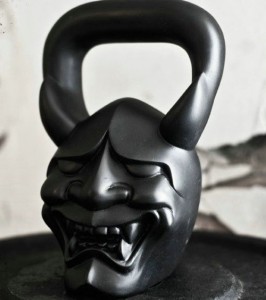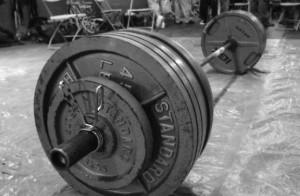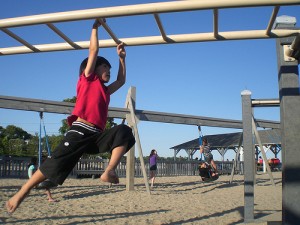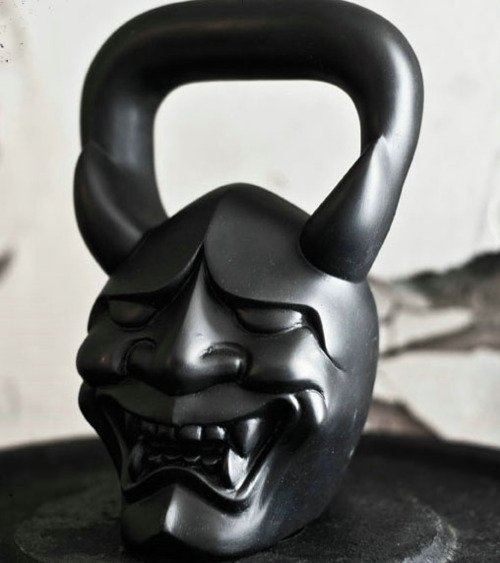Your setbacks are your fault. Don’t blame the injuries. Don’t blame the program. Don’t blame the equipment. Blame yourself. In all likelihood, your program isn’t failing because it’s bad. It’s failing because you think it’s bad. And then that means you’re not giving the same effort you otherwise would if you had faith in it. You aren’t [...]
 Your setbacks are your fault. Don’t blame the injuries. Don’t blame the program. Don’t blame the equipment.
Your setbacks are your fault. Don’t blame the injuries. Don’t blame the program. Don’t blame the equipment.
Blame yourself.
In all likelihood, your program isn’t failing because it’s bad. It’s failing because you think it’s bad. And then that means you’re not giving the same effort you otherwise would if you had faith in it. You aren’t going “all in.”
But in your defense, it’s confusing out here in the battlefield. The weapons are numerous. There are barbells, kettlebells, dumbbells, sandbells, and practically any other bell you have enough money to patent. And the machines? Treadmills, elliptical, rowers, and bikes. And that’s if you narrow it down to contraptions that liken us to gerbils — creatures that actually enjoy running inside of a wheel that never moves.
Let’s not forget about the techniques. Isometrics, plyometrics, concentrics, force spectrum ramping, and good old dynamic contractions. You start to wonder if there is method to the madness or just madness in the methods.
It’s no wonder you always feel inadequate. One day you’re toying around with time proven dumbbells and someone starts swinging a kettlebell in your face.
Your dumbbells don’t look quite the same after that.
I mean, they’ve been around forever. They have to be outdated, right?
And as soon as that thought creeps into your mind, your program — carrying your motivation — flutters out of the window.
 You would rather be playing with the fancy toys.
You would rather be playing with the fancy toys.
But there is a similar process in nearly every field. Take writing for example. Novices try to razzle and dazzle with old clichés like, well, razzle and dazzle. They use impressive words, overlooking the ones that are common to everyday language, the ones that actually resonate with our brain.
But let’s get back to your training. The more complicated it is, the more setbacks you will have. You’ll fall to the fads only to realize that your original plan was more effective. You’ll hop from your new program back to your old, yet more effective, one. But because you abandoned it, it takes you three months to work your way back to your baseline. And during those three months, you don’t notice any progress. And for good reason.
You never really progressed. You just worked your way back to your previous level.
Since no change took place, your confidence teeters. This begins the impatience. So when you see that person in the corner of the gym doing iso-quasi-mio-plio-nano contractions, you falter again. And the cycle continues. But just imagine where you would be if you stayed on your original program for the six months that it took for all of this to transpire.
A lot of people choose gyms based on equipment. Its gotta’ have treadmills, bikes, free weights, machines – the works. I mean, you’re paying for it, right? The owner should put your money to good use.
Likewise, people create home gyms with racks, bars, plates, dumbbells, chains, bands, and the latest gadget you can think of.
But remember what I said about writing? About keeping it simple? Well, I’m going to propose to you a radical – and simple – way to achieve every goal you’ve ever had. It may sound crazy, but that’s because it is. You will, however, save yourself years of anguish.
There are two ways to execute this “crazy” plan. The first involves cleaning out a spare bedroom, basement, or garage (any extra space with head room), and buying one of those barbell sets with 315lbs of total weight. If that doesn’t sound enjoyable, then continue going to your gym, but pretend like the only equipment there is a barbell and 315lbs of total weight.
As you can guess, your training will only involve the barbell and 315lbs in weight. No power rack. No dumbbells. Just you, the bar, the plates, and the ground. Your program will be built around the overhead press, front squat, barbell row, and clean. Now, of course, you can do things like push presses and deadlifts but you’re going to narrow your sights for now because I can already see your mouth opening up for questions.
“But what if I can deadlift more than 315? Shouldn’t I use more weight?”
And if you’re legitimately asking that question right now, I suggest you go back a re-read the previous three paragraphs. Before anything else spits out of your mouth, let me explain just why this workout is everything you’ll ever need.
 You’re not going to have small shoulders if you can press 225 over your head, you’re not going to have small legs if you can front squat 315, and you’re not going to have a small backside if you can clean 315.
You’re not going to have small shoulders if you can press 225 over your head, you’re not going to have small legs if you can front squat 315, and you’re not going to have a small backside if you can clean 315.
Now there are other hidden gems in a program, like having to clean the bar anytime you overhead press or front squat. This is what I like to call hidden volume. And hidden volume adds up over time to produce fantastic results.
But let’s get serious: is it possible to hit those strength numbers without fancy assistance exercises or special techniques?
Well, I dare you to find out. I dare you to spend the next year doing one of the programs below. I dare you.
There is no superior program, just some guidelines. Guidelines like attacking the barbell a minimum of three days a week, or a maximum of five days a week. Guidelines like making sure you work the movements in question with some intensity and passion. (That’s not to say work to failure, but just make sure you challenge yourself.) Guidelines like add weight when it feels comfortable. (You don’t need percentages to tell you when you’re strong enough to add another five or ten pounds.)
If you’re a four day per week kind of guy (or gal) that likes to have one focus per session, then whipping up a program is simple.
Day One: Push presses, barbell rows, arm work
Day Two: Deadlifts, front squats (light), anything else for the glutes or lower back
Day Three: Military, rows (different grip or back angle), arm work
Day Four: Cleans, front squats (heavy), anything else for the glutes or lower back
If you’re a three day per week kind of guy (or gal), then I’m going to “steal” a little program from Dan John. He says this program works, and if I were you I’d listen to him. He calls it The Southwood Program, but we’re going to alter it a bit. I guess you can call it The Northwood Program.
It’s to be done three days per week. All exercises follow the same 8-6-4 scheme as outlined in The Southwood Program. The exercises, in order, are the power clean, military press, front squat, and barbell row.
I know you’re not going to be satisfied with this, so I have a curveball for you. Since I know you’re going to do extra work, I might as well give you permission.
 “Walk in the park” one day every week, and do some calisthenics. Do chin-ups on the swing set. Climb across the monkey bars a few times. Flip yourself on top of them and do some dips. Climb down and work on your handstands.
“Walk in the park” one day every week, and do some calisthenics. Do chin-ups on the swing set. Climb across the monkey bars a few times. Flip yourself on top of them and do some dips. Climb down and work on your handstands.
Be an idiot and have some fun with it. You’ll likely fall in love with being outside and doing this sort of thing. I’m tempted to tell you that you can do these workouts “as often as weather permits” but I don’t want you to lose focus of the benefits a barbell brings.
Now, you don’t have to use the programs above. They are just examples. But remember, the novice writer always out-works himself. He finds ways to add to his sentences, ways to make them more lavish. The experienced writer, however, looks for ways to subtract — ways to make things simpler.
You can experience this for yourself, or you can just take my word for it.
What’s it going to be?
+++++
I’d appreciate it if you shared this post and dropped your questions below. I’d love to hear from you.
